Slack Recurring Reminders: When and How to Use Them
In this post, we'll show you how you can set up recurring reminders in Slack. We'll also explore some common and important use cases.


You probably use Slack for more than just communication. It's your go-to productivity tool because of the plethora of features it offers, from storing important files, assimilating data from external sources, and making your to-do lists to setting up reminders. Slack lets you conveniently create, set up, edit, and delete both one-time and recurring reminders.
In this post, we'll show you how you can set up recurring reminders in Slack. We'll also explore some common and important use cases. Let's get the ball rolling!
Set up a One-Time Reminder
Let's first cover how you can set up a simple one-time reminder. One-time reminders are great for tasks that you don't have the time or attention to deal with as they pop up. For instance, you might be in a meeting, and one of your managers or coworkers asks you to deliver something by the end of the day. You can set up a one-time reminder for that task that will go off when the meeting is over. Here are the steps to do so.
The quickest way to set up any reminder is by navigating to your own chat. Press the plus icon in the bottom-left corner:

That should open a pop-up menu with a 'Create Reminder' option. Go ahead and click that.

Now a pop-up form opens where you can fill in the details of the reminder.

Fill in the important details here. You can choose the day and time you want the reminder to be set to. Then you can write your reminder in the Description field. Once you've filled in those details, hit the Create button:
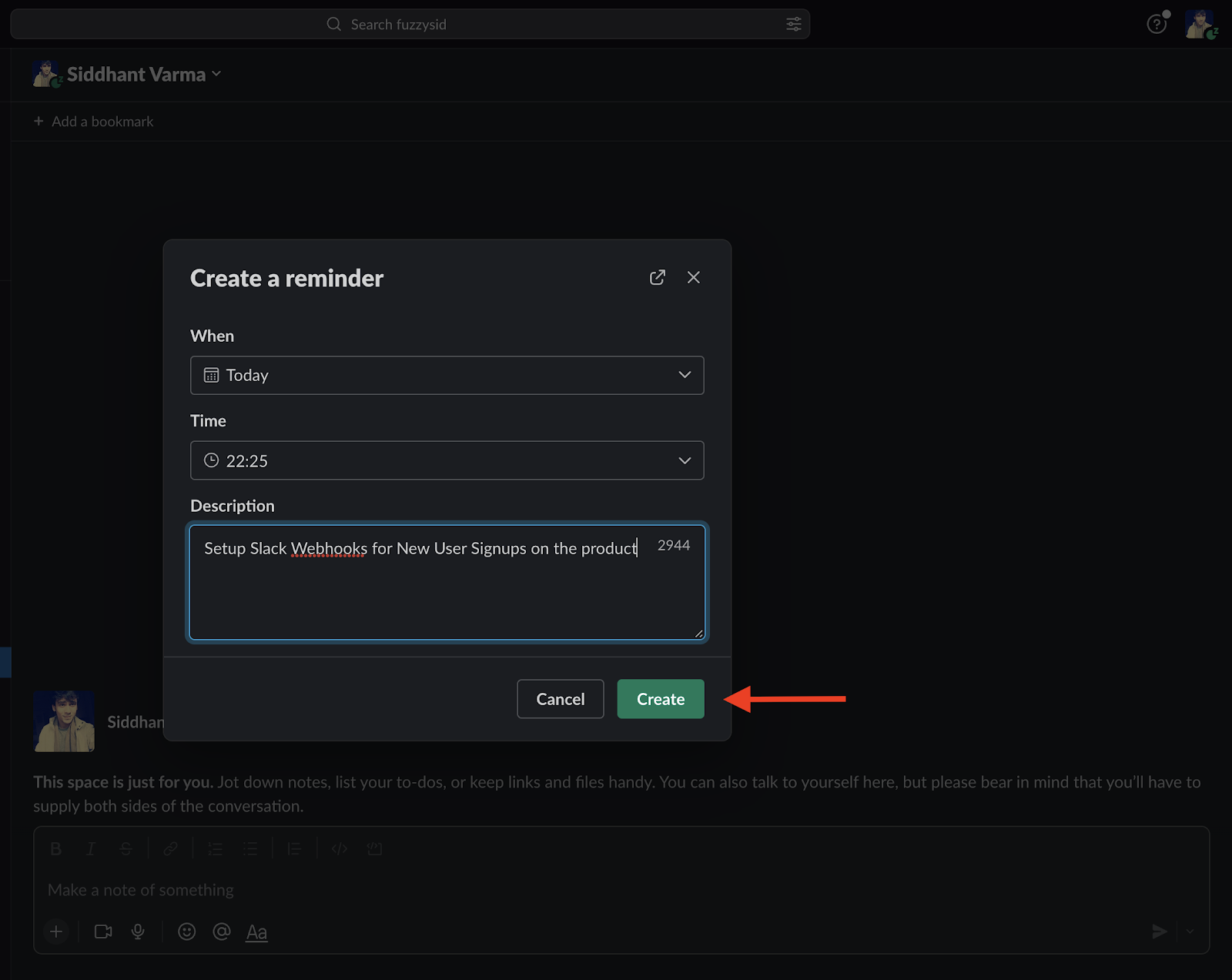
Congrats! You’ve created a reminder. Slackbot will immediately send you a message to confirm the reminder.
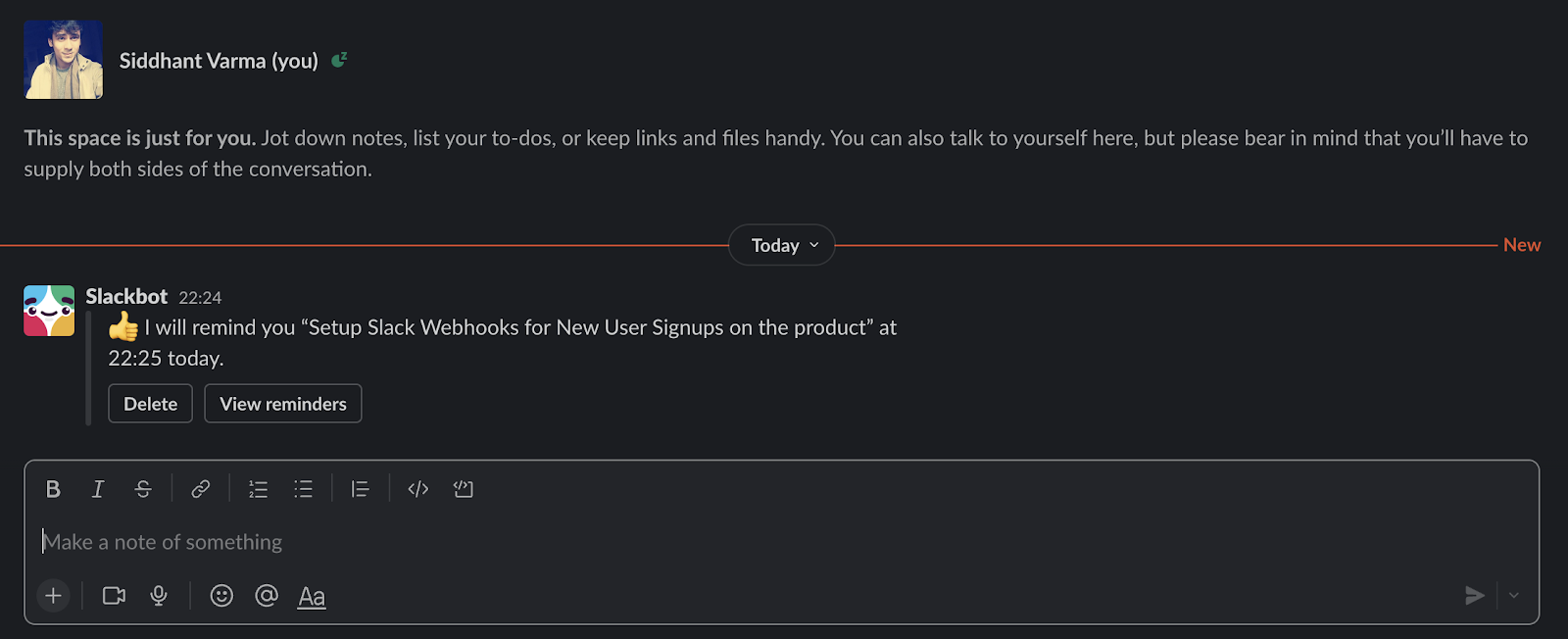
When the reminder is due, you'll get a notification and a new reminder message from the Slackbot.

You can snooze this reminder if you want it to appear again later, much like how you snooze your morning alarms!

Or you can click the 'Mark as complete' button to mark the reminder complete.

Great, that was easy, right? Now let's extend this to setting up recurring reminders in Slack.
Set up a Recurring Reminder
You've already seen where and how to create a reminder. But if you recall, the reminder pop-up form didn't have an option to schedule the reminder periodically, or in other words to make it recurring. But you can set up recurring reminders in Slack if you know a few tricks.
Reminder Command Format
The general reminder command is /remind [@someone or #channel] [what] [when]. This means that if you type this out in the 'Create Reminders' description box, a reminder will be set based on the parameters you specified in that command. Let's break this down.
- /remind marks the beginning of the reminder command. Nothing too fancy—it's just there.
- [@someone or # channel] indicates whom the reminder is meant for. You can set it for another member in your Slack workspace or for an entire channel.
- [what] refers to the actual reminder message. So, a command like '/remind me to draft newsletter' will set the reminder message to be 'Draft Newsletter.'
- [when] refers to the time of the reminder. This is the catch. You can use this [when] to set a periodic time for the reminders.
Expanding the above with a few common examples, here's what some of the reminder commands could look like:
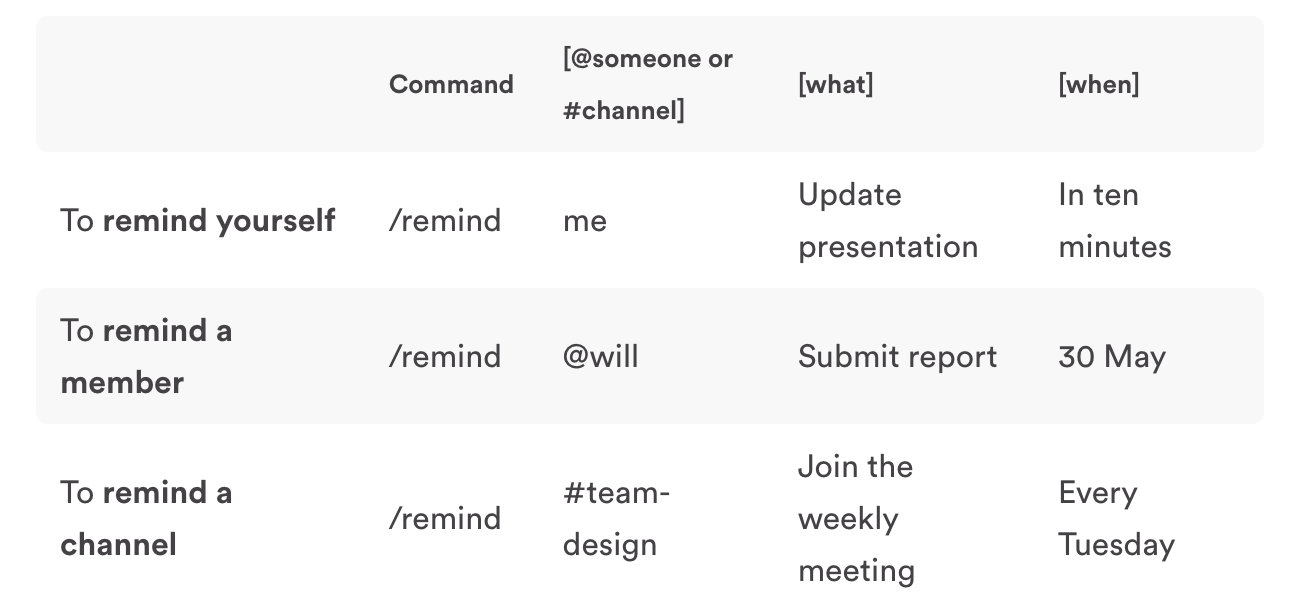
Create a Recurring Reminder
Enough theory. Go to the #general channel and type the following reminder command in the message box:
/remind #general to submit reimbursements on the 25th of every month
Here's the command in action:
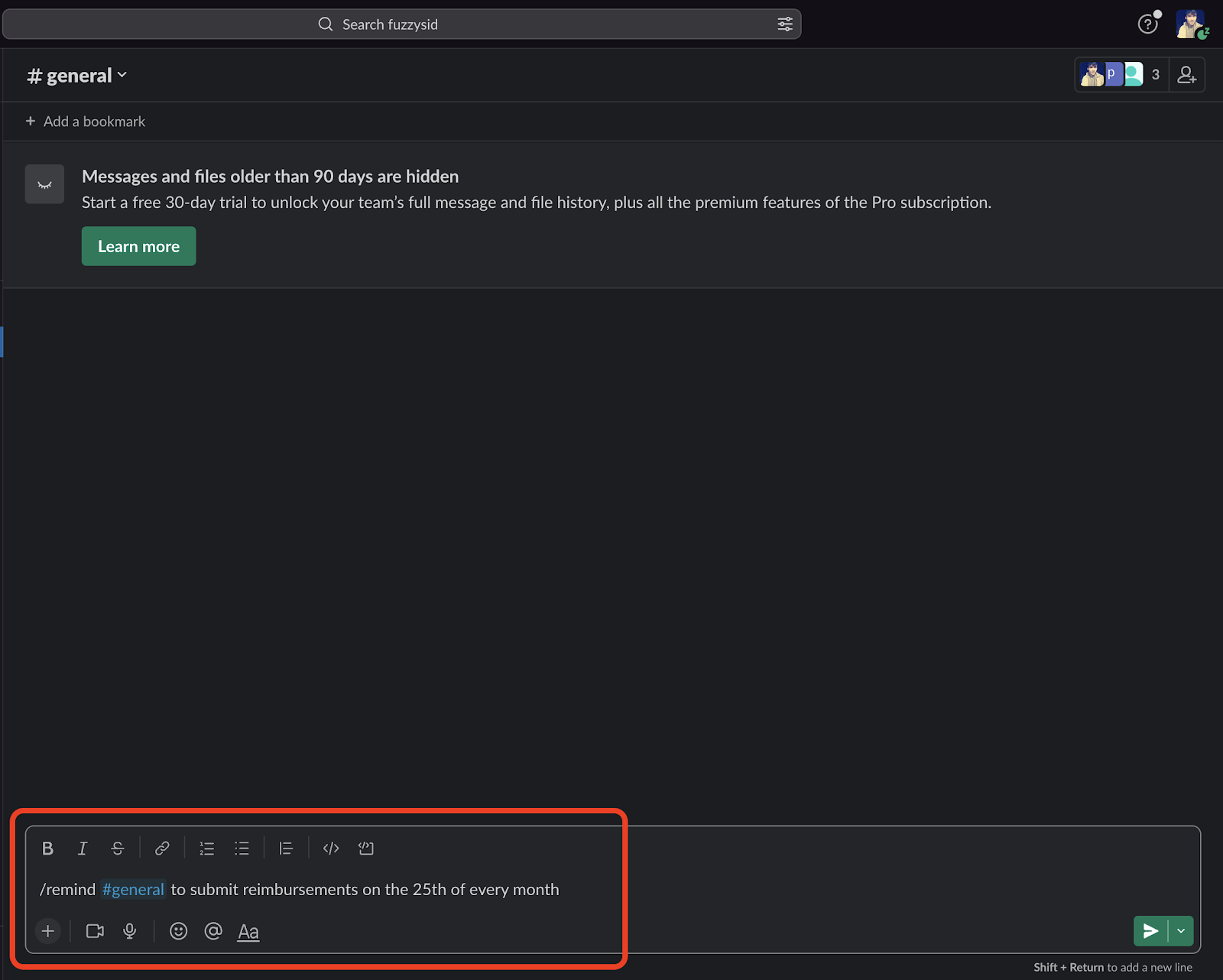
Now when you send this message, a reminder will be set for the 25th of every month at 9:00 a.m. This reminder will be sent to the channel itself. Other people in the channel will also see when you set the reminder, but the Slackbot's confirmation will only be visible to you.
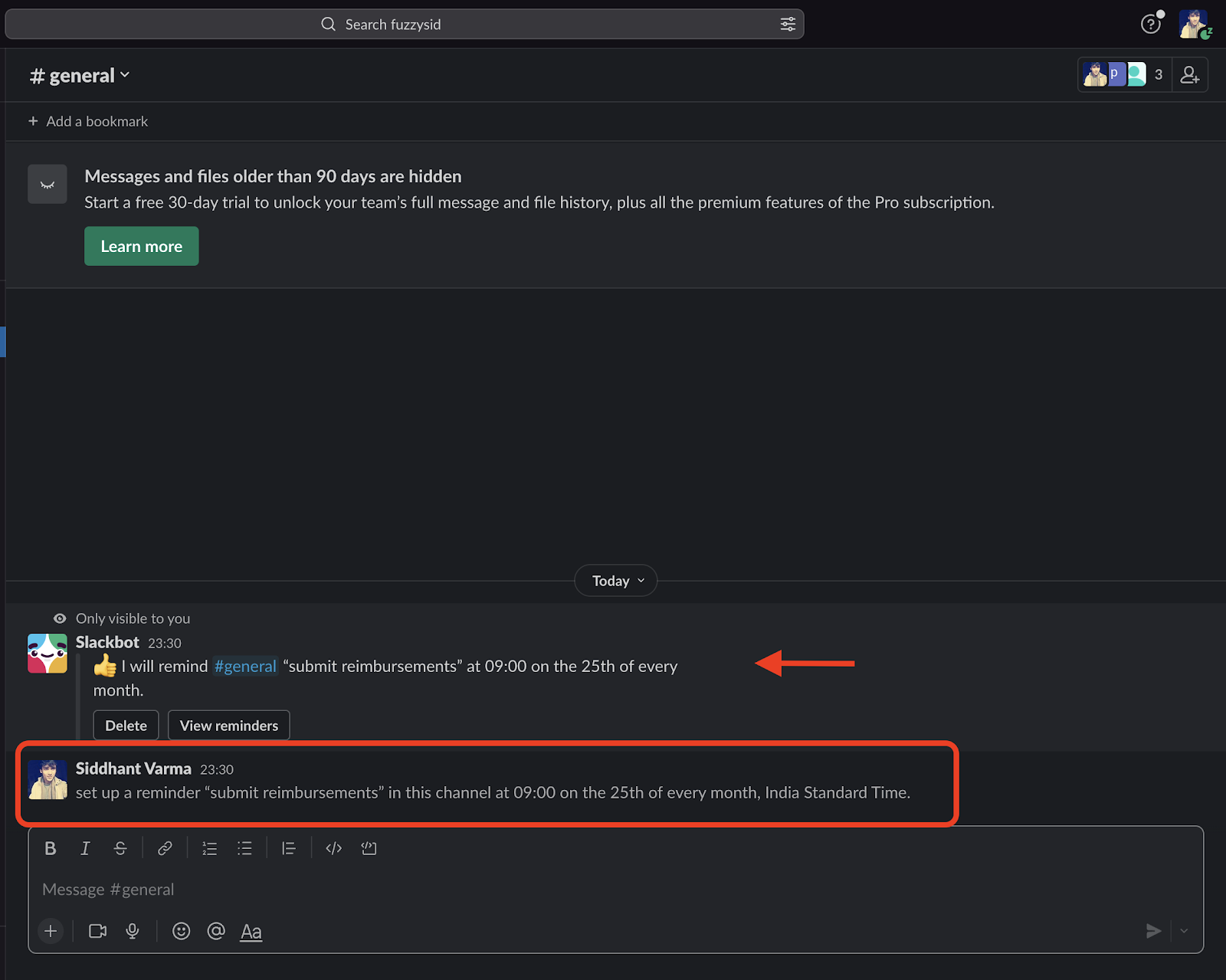
Delete a Recurring Reminder
Did you set a reminder on the wrong channel or want to delete a recurring reminder? You can easily do so via the Delete button in the reminder confirmation:

Once you hit that delete button, the reminder should go away.

Edit a Recurring Reminder
You can’t edit recurring reminders. However, you can delete a recurring reminder you've accidentally set. Then you can create another recurring reminder to replace the original. For instance, let's say I set the following reminder:
/remind #general to submit reimbursements on the 30th of every month

That should set the same reminder you saw in the previous section, but instead it reminds everyone on the 30th of every month.

Well, fair enough, your finance team is efficient, and you're a small startup, so it shouldn't take long to process the reimbursements. But wait, February doesn't have a 30th! You'll need to delete this reminder.

And now you can create another one but set the recurring date to the 27th instead:
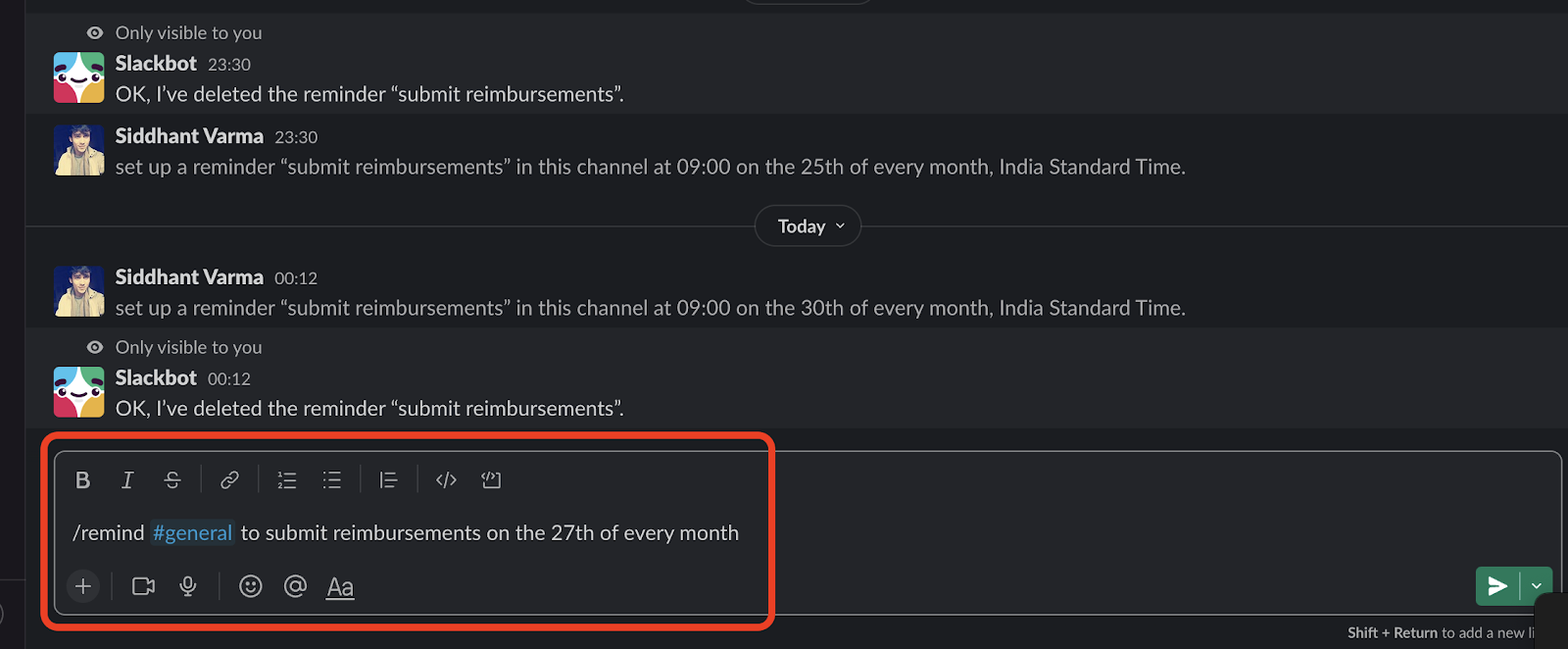
And that should set the same reminder to the 27th of each month.

Awesome! You have now effectively edited your reminder.
How Do I See Recurring Reminders in Slack?
Realizing how powerful recurring reminders are, you may want to set a ton of them. In order to see them all in one place, you can simply click the 'View Reminders' button.

That should open a list of reminders you've set.

Slackbot will then show you the reminders set in the current channel and the upcoming reminders. It also gives you an option to view other reminders in the past that you've marked as complete.

Alternatively, you can type in the /remind list command anywhere to see all your reminders.
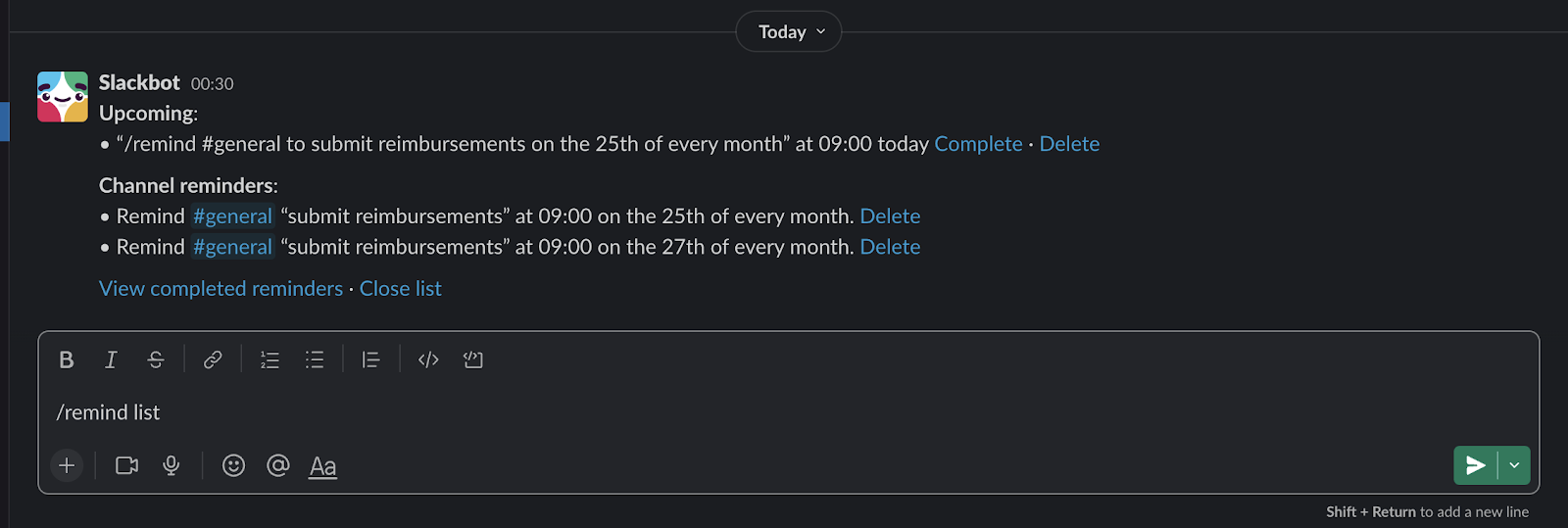
Set up Recurring Reminders: Custom Use Cases
Hopefully by now you're confident in setting up any type of recurring reminders you want. If not, let's practice more using some common use cases.
Every Day
You probably have sync-up or stand-up calls to discuss what your teammates have been up to during the day. It's more efficient if your teammates also include their updates. You can set a daily reminder for your teammates to send their updates on the general channel. Or you can send them a reminder to add to, say, the sprint channel what they'll be working on today. Here's how you can do that:
/remind #sprint Hey @sprint What’s on your plate for today? every weekday at 10:30
That should send a reminder on the #sprint channel for everyone to put down what they plan to do today.

If you're not on Slack by default, reminders appear as a Slack notification as well.

And of course, the actual reminder appears on the #sprint channel.

Great! Daily reminders can be pretty useful, and we'll explore some more use cases in the 'When to use reminders' section.
Every Week
Your content team needs to ship a weekly newsletter, so let's remind them to do so every week. Here's what a recurring reminder for every week looks like:
/remind @Siddhant Varma to send weekly newsletter draft every Thursday at 10:40
I'm purposely choosing the day and time so that I get a reminder shortly after writing this so I can actually show it to you in action. However, you can set the day and time to be anything you want.

This reminder is set for me, and when it's due I'll send the draft of the weekly newsletter to the reviewer.

Awesome! Can you think of other cases where you need to set weekly reminders? Think hard, there are many!
First Day of the Month
If you have functionalities across different teams that are more relaxed in nature, you might check in with them every month or so instead of meeting daily or weekly. So, let's set a reminder to check in with the sales team every month on how they're doing:
/remind me to check-in with the sales team on the 1st of every month
That should set a reminder that pops up on the 1st of every month:

For Other Team Members
Reminders can be set for other team members as well. All you have to do is specify the member using the @ in your reminder command. Let's set a reminder for a team member to monitor back-end error logs every day using the following remind command:
/remind @pragya varma to monitor backend error logs every day at 4:00 p.m.
Did we create a recurring reminder for another team member?

Oops! We couldn't. Recurring reminders can't be set for other members. So, what are the ways around this? Well, recurring reminders can be set in channels, as you've already seen, so you can set them in a specific channel that you can create for those members. Or you can set a one-time non-recurring reminder:
/remind @pragya varma to monitor back-end error logs tomorrow at 4:00 p.m.

And then remind yourself to run the above remind command every day with something like this:

You can also go ahead and automate this using Slack workflows.
When to Use Reminders? Important Use Cases
I bet you're sold on how important reminders can be for you. You can use them in a number of use cases—for you, your members, and for your entire team.
To supercharge your team's productivity, you can use reminders for your team to share their weekly or daily updates in a channel. This will help everyone stay in touch with what everyone on your team has been up to. You can also use them to remind your team about deadlines and tasks well in advance, such as a yearly reminder to do taxes a few months before the end of the financial year or a quarterly reminder to write their review reports.
In the era of remote work, reminders can be tuned for much more than just work-related items. For instance, you can set a bunch of birthday reminders in one of your Slack channels so that everyone is notified of an upcoming birthday for a member.
To supercharge your team's productivity, you can use reminders for your team to share their weekly or daily updates in a channel.
You can also set weekly reminders for your entire team to share their high points and low points of the week or a quarterly reminder to take a small vacation because a good downtime ensures productive uptime. You can also remind yourself about specific messages in case someone sent you an important message that you need to pay more attention to later on. Just click the triple dots on a message to open the 'More actions' pop-up menu.

Then choose the 'Remind me about this' option and select a time from the list. You can also customize this.
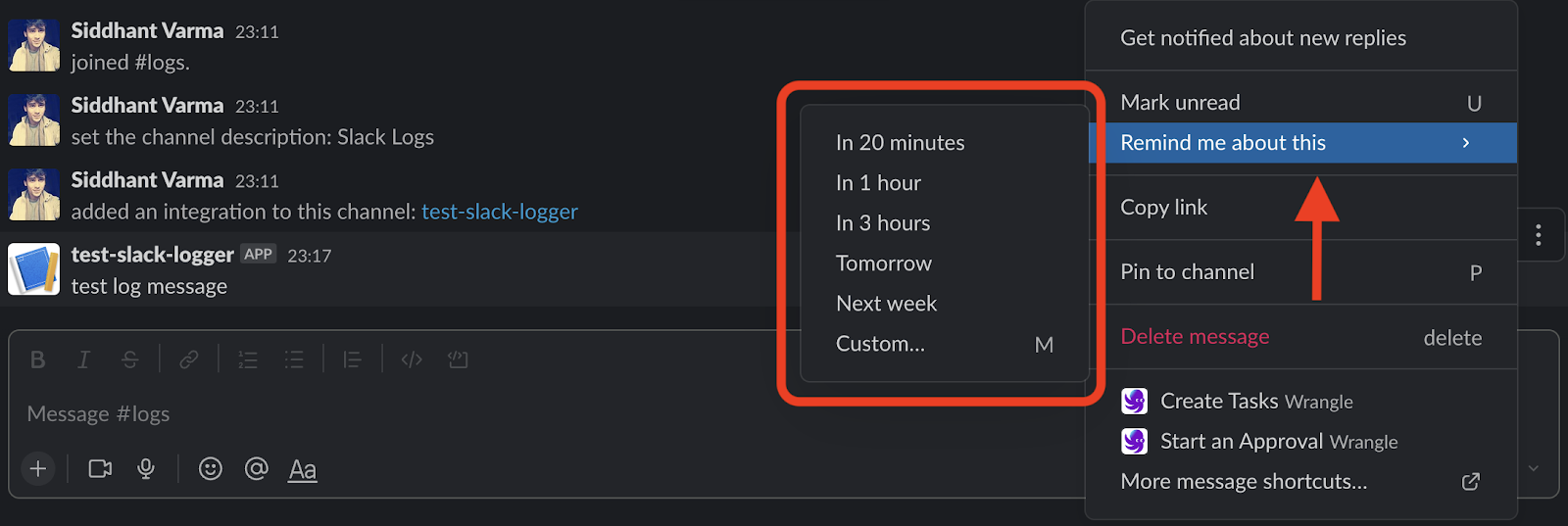
Once you do that, Slack will remind you about that message so won't miss anything important from your teammates

Slack Recurring Reminders Conclusion
Reminders are great, but in order to go the extra mile, you'll need to automate them using custom Slack workflows. One of the examples we explored was setting recurring reminders for your teammates. However, building a custom Slack workflow can feel like a daunting and difficult process. In that case, you can use Wrangle to build custom Slack workflows easily. Until next time!
Wrangle takes Slack automation to a whole new level. Imagine automating mundane tasks like IT ticketing, customer support, document approvals, creative reviews and more all in your Slack channels. Wrangle lets you build automated workflows and ticketing with custom forms that bring order to the chaos of your Slack channels. Get started for free or request a demo.
This post was written by Siddhant Varma. Siddhant is a full stack JavaScript developer with expertise in frontend engineering. He’s worked with scaling multiple startups in India and has experience building products in the Ed-Tech and healthcare industries. Siddhant has a passion for teaching and a knack for writing. He's also taught programming to many graduates, helping them become better future developers.

- Try Wrangle free for 14 days
- Turn messages into trackable tickets
- Build a scalable help desk


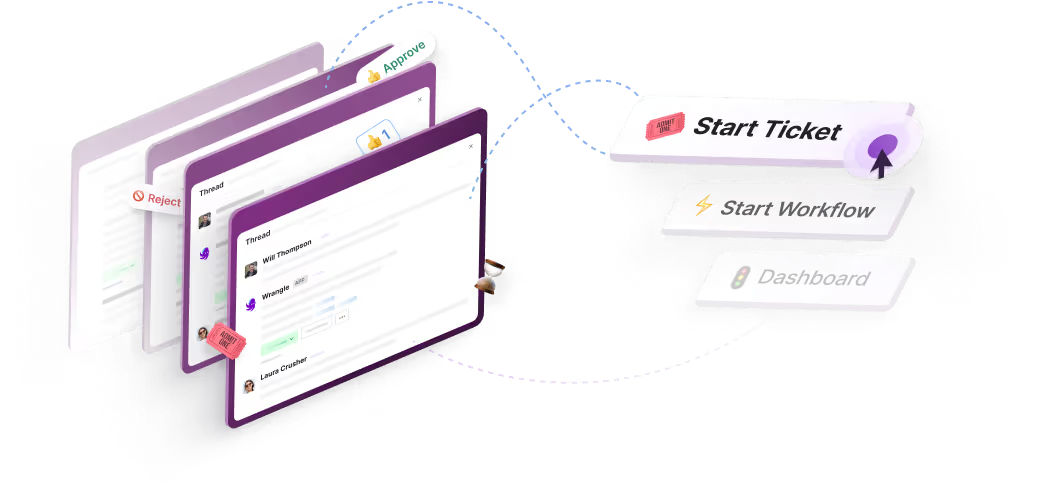
Turn Slack into a productivity powerhouse with Wrangle
Create a scalable helpdesk in Slack. Automatically turn messages into trackable tickets and provide faster, more transparent service to your colleagues and customers with Wrangle — Try it free!






